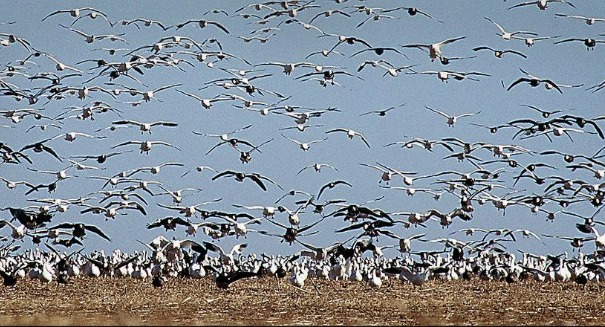
The geese were headed to Alaska when they fell out of the sky, and wildlife officials quickly scooped up the dead bodies to keep it from spreading to birds that might eat them, such as eagles.
About 2,000 migrating snow geese suddenly dropped out of the sky in Idaho, and wildlife officials believe avian cholera is to blame.
The Idaho Department of Fish and Game have collected the dead birds over the last few days near the towns of Roberts and Terreton, and they believe that avian cholera has infected the birds, which can result in erratic flight and convulsions, according to a Fox News report.
The geese were headed to Alaska from the Southwest and Mexico, where they had spent the winter breeding.
Scientists aren’t sure where they got the bacteria, but outbreaks of avian cholera aren’t unheard of and can happen on occasion, said regional Fish and Game supervisor Steve Schmidt as quoted by the report.
Schmidt noted that wildlife officials made it a priority to collect the dead animals quickly in order to prevent other birds from getting the virus by feeding on the dead birds. Especially at risk is the population of about 20 eagles in the region, although there was no indication that they had been exposed.
Avian cholera can spread quickly within a flock of birds, and it can result in them suddenly falling out of the sky without warning. The disease does not pose a danger to humans. There have so far not been any reported deaths of other snow geese in other states.
A long trumpeter swan was among the dead geese, and it appeared to have contracted the virus as well.
About 10,000 snow geese fly through Idaho ever spring, using the state has a stopover where they gorge themselves on nearby wheat fields for a couple weeks.
Avian cholera is commonly found in chickens, and cocks are more susceptible to the disease than hens. Turkeys, ducks, raptors, canaries, and geese are all capable of contracting the virus, with turkeys particularly at risk.
Famous scientists Louis Pasteur was the first to isolate the virus and grow it in a pure culture in the 1880s. It originated in Europe and was first recorded in North American in the 1940s. Since then, outbreaks have been frequently recorded in wild birds, and is most prevalent in wild waterfowl. Usually, the outbreaks happen in cold and wet weather, and are often traced back to rodents.
Green diarrhea is an early symptom of the virus, but there often isn’t much physical indication of the disease untilt he bird suddenly dies.

A snow goose, also known as the blue goose, is a species of goose from North America that is known for its white plumage. It breeds in Greenland, Canada, and Alaska, and as far west as the northeastern tip of Siberia. During the winter, it hangs out in the warmer parts of North America, which can extend from as far north as British Columbia to as far south as Mexico before returning to the Arctic in the spring. It can sometimes be found in Europe, but usually as a result of an escape from a breeder or collector. They do, however, often visit the British Isles, and there is a feral population in Scotland.
Leave a Reply